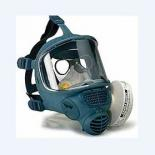Evaluate Gas Mask Seal Pressure Distribution
Challenge
A close-fitting seal between a gas mask and the contours of a person's face and head is essential to keep unwanted chemicals from being inhaled. The interface pressure must be very light, or the wearer will reject the mask as uncomfortable. The size, shape, and contours of individual faces vary over a significant range, and there is the added complexity of facial and scalp hair. Measuring sealing pressures of candidate designs is accomplished with paper-thin, flexible sensors that fit between the mask and skin without disrupting the fit.
Solution
Tekscan's pressure sensors have high sensitivity and cover a distance both along the seal and across it with an array of active elements so pressure distribution can be mapped. I-Scan™ pressure mapping software provides vivid displays and facilitates comparisons between designs and during simulated operating conditions. With the help of Tekscan’s highly qualified sales and engineering support team, each system may be configured to meet your specific needs.
Gas Mask Seal Pressure Measurement Applications
- Design verification testing
- Reliability testing
- R&D for new designs
Benefits of Pressure Mapping
- Identify and troubleshoot leaks
- Improve design
- Compare performance on different size/shape heads
